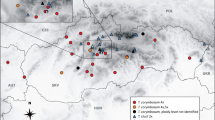Abstract
Analysis of several populations in a large part of the distribution area of the genusEmilia in Brazil has revealed only two species: the diploidE. sonchifolia and the tetraploidE. fosbergii. The more widely reportedE. coccinea was not found. They show a karyotype constancy in morphology and chromosome number (2n = 10 and 2n = 20, respectively), C-banding pattern and number of secondary constrictions. Some indications were found thatE. fosbergii may be an allopolyploid and that its ancestors had different genome sizes.
Similar content being viewed by others
References
Badr, A., Elkington, T. T., 1984: Giemsa C-banded karyotypes and taxonomic relationship of some N. AmericanAllium spp. and their relationship to Old World species (Liliaceae). — Pl. Syst. Evol.144: 17–24.
Baldwin, J. T., Jr., 1946: Cytogeography ofEmilia Cass. in the Americas. — Bull. Torrey Bot. Club73: 18–23.
—,Speese, B. M., 1949: Cytogeography ofEmilia in West Africa. — Bull. Torrey Bot. Club76: 346–351.
Barkley, T. M., Cronquist, A., 1978:Emilia. — In: North American Flora Ser. II, part 10, pp. 147–150. — New York: The New York Botanical Garden.
Coleman, J. R., 1968: Chromosome numbers in some BrazilianCompositae. — Rhodora70: 228–240.
—,Campello, M. L., 1984: Cytogenetics of a mixed Brazilian population ofEmilia sonchifolia (L.) DC. andE. coccinea (Sims)G. Don (Compositae). — Rev. Brasil. Genet.7: 83–94.
Fedorov, An. A., (Ed.), 1969: Chromosome numbers of flowering plants. — Leningrad: Komarov Botanical Institute.
Frankel, O. H., Gerlach, W. L., Peacock, W. J., 1987: The ribosomal RNA genes in synthetic tetraploids of wheat. — Theor. Appl. Genet.75: 138–143.
Goldblatt, P., 1981: Index to plant chromosome numbers 1975–1978. — St. Louis: Missouri Botanical Garden.
Guerra, M. S., 1983: O uso do Giemsa na citogenética vegetal—comparação entre a coloração simples e o bandeamento. — Ci. & Cult.35: 190–193.
—, 1986a: Citogenética de angiospermas coletadas em Pernambuco 1. — Rev. Brasil. Genet.9: 21–40.
—, 1986b: Reviewing the chromosome nomenclature ofLevan & al. — Rev. Brasil. Genet.9: 741–743.
—, 1988: Characterization of different types of condensed chromatin inCostus (Zingiberaceae). — Pl. Syst. Evol.158: 107–115.
Kodama, Y., Yoshida, M. C., Sasaky, M., 1980: An improved silver staining technique for nucleolus organizer regions by using a nylon cloth. — Japan. J. Hum. Genet.25: 229–233.
Lacadena, J. R., Cermeno, M. C., Santos, J. L., 1984: Evidence for wheat-rye nucleolar competition (amphiplasty) inTriticale by silver-staining procedure. — Theor. Appl. Genet.67: 207–213.
Lorenzi, H., 1982: Plantas daninhas do Brasil: terrestres, aquáticas, parasitas, tóxicas e medicinais. — Nova Odessa: Edição do Autor.
Nicolson, D. N., 1975:Emilia fosbergii, a new species. — Phytologia32: 33–34.
—, 1980: Summary of cytological information onEmilia and the taxonomy of four Pacific taxa ofEmilia (Asteraceae: Senecioneae). — Syst. Bot.5: 391–407.
Nogueira, M. T. M., Guerra, M. S., 1983: Número cromossômico deEmilia sonchifolia (L.) DC. eEmilia sagittata (DC.)Vahl. em populações brasileiras. — Ci. & Cult.35 (supl.): 662.
Olorode, O., 1973: Meiotic studies of diploid hybrids betweenEmilia sonchifolia andE. coccinea (Compositae). — Cytologia38: 725–729.
—,Olorunfemi, A. E., 1973: The hybrid origin ofEmilia practermissa (Senecioneae: Compositae). — Ann. Bot.37: 185–191.
Schwarzacher, T., Ambros, P., Schweizer, D., 1980: Application of Giemsa banding to orchid karyotype analysis. — Pl. Syst. Evol.134: 293–297.
Siljak-Yakovlev, S., Cartier, D., 1982: Comparative analysis of C-band karyotypes inCrepis praemorsa subsp.praemorsa and subsp.dinarica. — Pl. Syst. Evol.141: 85–90.
Torres, A. M., Liogier, A. H., 1970: Chromosome number of DominicanCompositae. — Brittonia22: 240–245.
Turner, B. L., Irwin, H. S., 1960: Chromosome number in theCompositae 2. Meiotic counts for fourteen species of BrazilianCompositae. — Rhodora62: 122–126.
—,King, R. M., 1964: Chromosome number in theCompositae. 8. Mexican and Central American species. — Southwestern Naturalist9: 27–39.
Author information
Authors and Affiliations
Rights and permissions
About this article
Cite this article
Guerra, M.d.S., Nogueira, M.T.M. The cytotaxonomy ofEmilia spp. (Asteraceae: Senecioneae) occurring in Brazil. Pl Syst Evol 170, 229–236 (1990). https://doi.org/10.1007/BF00937706
Received:
Issue Date:
DOI: https://doi.org/10.1007/BF00937706




